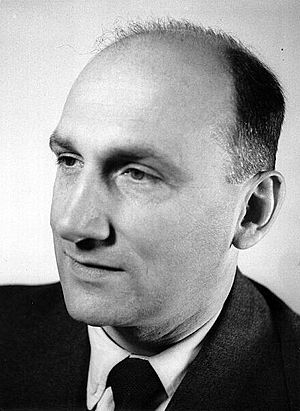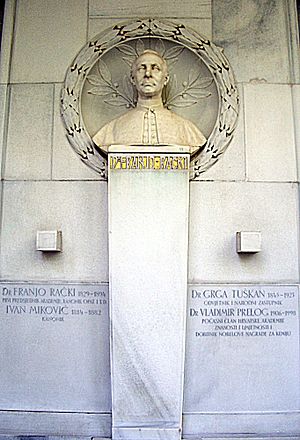Vladimir Prelog facts for kids
Quick facts for kids
Vladimir Prelog
|
|
|---|---|
 |
|
| Born | 23 July 1906 Sarajevo, Condominium of Bosnia and Herzegovina, Austria-Hungary
|
| Died | 7 January 1998 (aged 91) Zürich, Switzerland
|
| Alma mater | Czech Technical University in Prague (Sc.D, 1929) |
| Known for |
|
| Spouse(s) |
Kamila Vitek
(m. 1933) |
| Awards |
|
| Scientific career | |
| Fields | Biochemistry |
| Institutions |
|
| Doctoral advisor | Emil Votoček |
| Influences | |
Vladimir Prelog (23 July 1906 – 7 January 1998) was a famous chemist. He was born in Croatia and later became a Swiss citizen. In 1975, he won the Nobel Prize in Chemistry. He received this award for his important work on how molecules are shaped in 3D space. This field is called stereochemistry. Prelog lived and worked in different cities like Prague, Zagreb, and Zürich.
Contents
Early life and education
Vladimir Prelog was born in Sarajevo, which was part of Austria-Hungary at the time. His parents were Croatian. His father, Milan, was a history professor. When Vladimir was eight, he was near the spot where the assassination of Franz Ferdinand happened. This event helped start World War I.
Moving and schooling
In 1915, Prelog moved to Zagreb with his family. He finished elementary school there. He started high school in Zagreb, but then his family moved to Osijek. In Osijek, he became very interested in chemistry. His teacher, Ivan Kuria, inspired him.
When he was just 16, his first scientific paper was published. It appeared in a German science magazine called Chemiker Zeitung. The article was about a tool used in chemistry labs. After finishing high school in Zagreb in 1924, he went to Prague. He studied chemical engineering at the Czech Technical University in Prague. He earned his science doctorate (Sc.D) in 1929. His teacher, Emil Votoček, and mentor, Rudolf Lukeš, helped him learn about organic chemistry.
After university, Prelog worked at a private company in Prague. There were not many university jobs because of the Great Depression. He made special chemicals that were hard to find. In his free time, he studied natural substances found in plants, like those in cacao beans.
Career and scientific discoveries
Prelog wanted to work at a university. In 1935, he became a lecturer at the University of Zagreb. He taught organic chemistry and chemical engineering.
Research in Zagreb
With his students, Prelog began studying quinine, a medicine used to treat malaria. A local medicine factory, "Kaštel" (now Pliva), helped him with money. He created a successful way to make Streptazol. This was one of the first sulfonamide medicines, which fight bacteria. In 1941, while in Zagreb, Prelog created the first man-made version of adamantane. This is a hydrocarbon with a very unusual shape.
Moving to Zürich
In 1941, during World War II, Prelog and his wife moved to Zürich, Switzerland. He was invited to lecture in Germany, and his friend Lavoslav Ružička helped him get to Switzerland. Ružička also helped him get support from a company called CIBA Ltd.. Prelog started working at the Swiss Federal Institute of Technology (ETH).
In 1944, Prelog did something amazing. He was able to separate two mirror-image forms of a molecule called Tröger's base. He used a method called chromatography. This showed that not only carbon atoms but also nitrogen atoms can be the "center" of a molecule's 3D shape. This was a big discovery in chemistry. Prelog became a full professor at ETH in 1952. In 1957, he took over from Ružička as the head of the chemistry lab.
Important work in Switzerland
Prelog was very interested in alkaloids, which are natural compounds found in plants. He studied the structure of solanine and strychnine. He even showed that a famous chemist's formula for strychnine was wrong. This made him well-known around the world. He also worked with other scientists to understand the structures of other plant compounds.
As new tools became available, Prelog started studying chemicals made by tiny living things, like bacteria. These chemicals often have unusual structures and interesting biological effects. He studied antibiotics and figured out the structures of compounds like nonactin and rifamycins. Prelog saw these natural products as a record of how life has changed over billions of years.
His work on medium-sized rings (molecules shaped like rings with 8 to 12 atoms) was very important. It helped scientists understand how the shape of a molecule affects its behavior. He also helped explain Bredt's rule, which is about where double bonds can exist in certain molecules.
Prelog also studied how to make specific mirror-image molecules. He created rules to understand how the starting materials affect the final product's shape. His research helped explain how enzymes (special proteins in living things) work to create specific shapes in chemical reactions.
The CIP system
As more and more molecules with different 3D shapes were discovered, it became hard to describe them. In 1954, Prelog worked with Robert Sidney Cahn and Christopher Ingold. They created a system to name and describe the exact 3D shape of molecules. This system is called the CIP system (Cahn-Ingold-Prelog). It uses "sequence rules" to define the absolute shape of a molecule. They published two papers together. After Cahn and Ingold passed away, Prelog published a third paper on the topic. In 1959, Prelog became a citizen of Switzerland.
Awards and recognition
Vladimir Prelog received many honors for his work.
- In 1960, he was chosen to be part of the American Academy of Arts and Sciences.
- In 1961, he joined the United States National Academy of Sciences.
- In 1962, he became a Foreign Member of the Royal Society in London.
- In 1975, he won the Nobel Prize in Chemistry. He shared it with another chemist, John Cornforth.
- In 1986, he became an honorary member of the Yugoslav Academy of Sciences and Arts. He was also a member of the Serbian Academy of Sciences and Arts.
Personal life
In 1933, Vladimir Prelog married Kamila Vitek. They had one son named Jan, who was born in 1949.
Prelog was a very smart person with a wide knowledge of culture. In 1991, he was one of 109 Nobel Prize winners who signed a message asking for peace in Croatia.
Vladimir Prelog passed away in Zürich when he was 91 years old. His ashes were buried in the Mirogoj cemetery in Zagreb in 2001. In 2008, a monument was put up in Prague to remember him.
See also
In Spanish: Vladimir Prelog para niños



